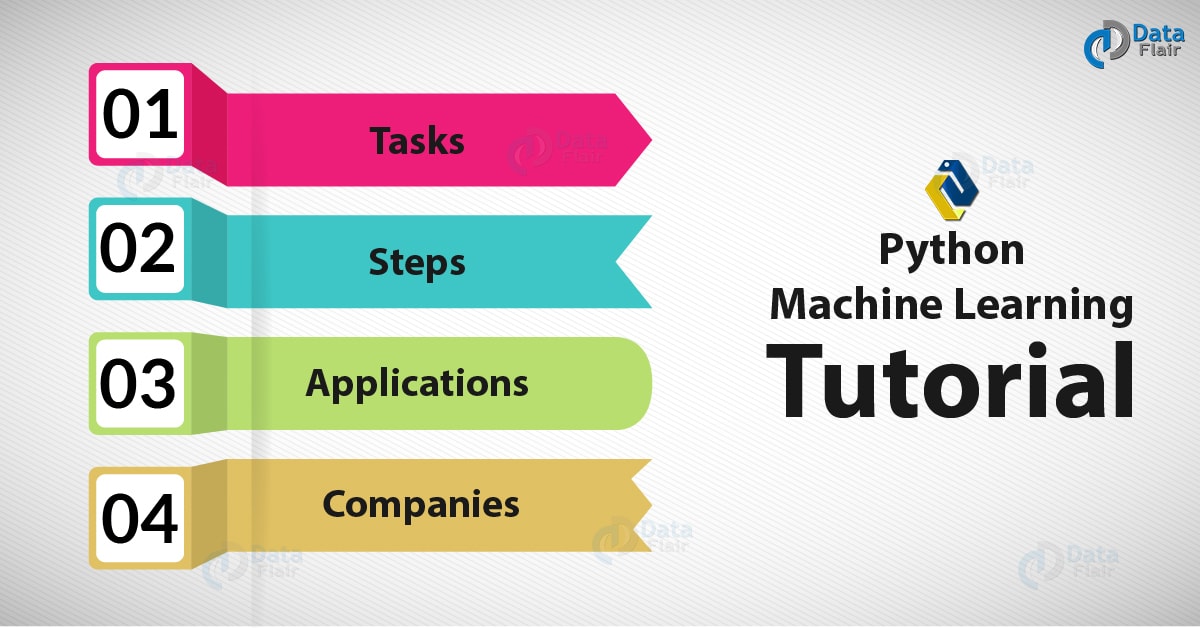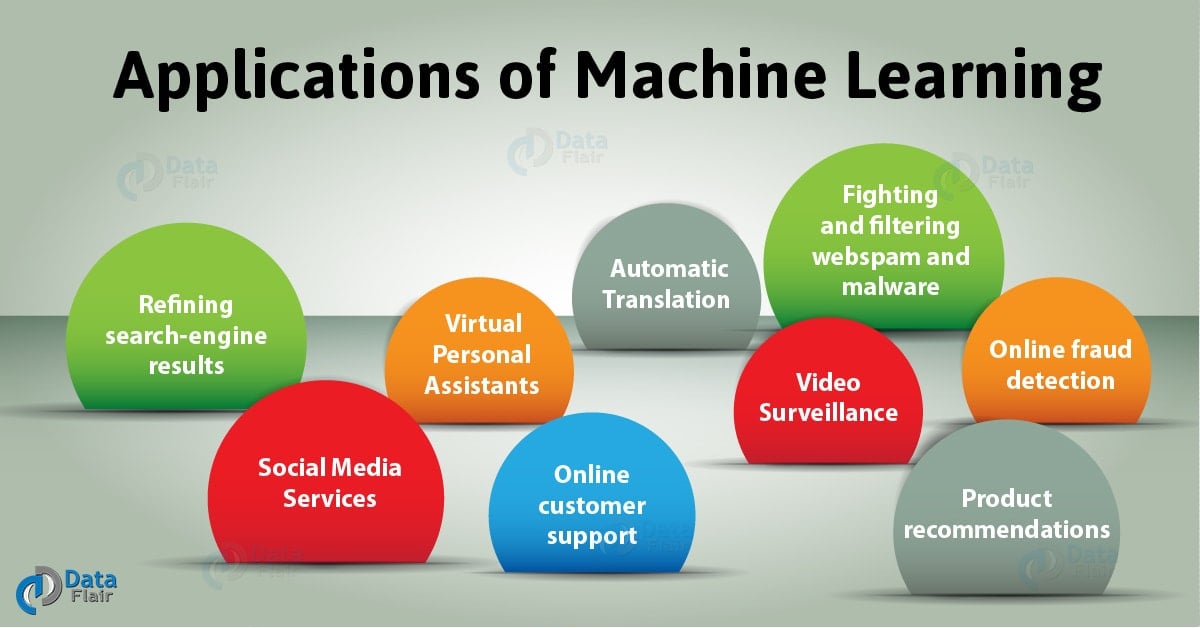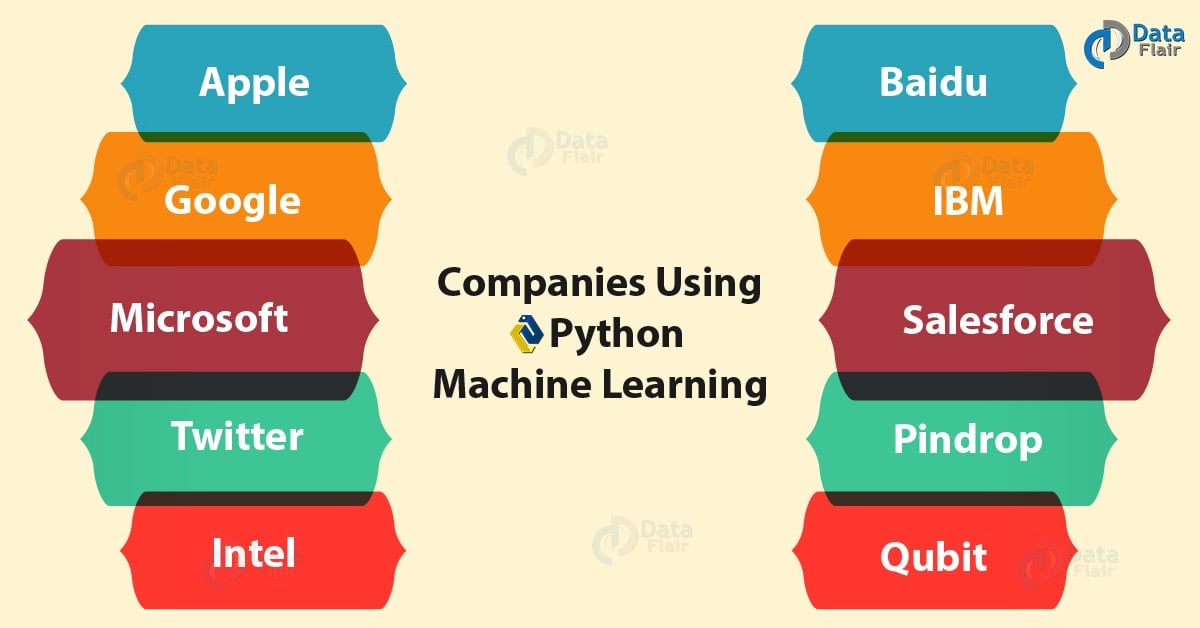Python Machine Learning Tutorial – Tasks and Applications
Free Machine Learning courses with 130+ real-time projects Start Now!!
Python course with 57 real-time projects - Learn Python
1. Python Machine Learning Tutorial
In this Python Machine Learning Tutorial, we will introduce you to machine learning with Python. Moreover, we will discuss Python Machine Learning tasks, steps, and applications. Then, we will take a look at 10 tech giants that adapt Python Machine Learning to improve what they do.
So, let’s start the Python Machine Learning Tutorial.
2. Introduction to Machine Learning With Python
In this Python Machine Learning Tutorial, Machine Learning also termed ML. It is a subset of AI (Artificial Intelligence) and aims to grants computers the ability to learn by making use of statistical techniques. It deals with algorithms that can look at data to learn from it and make predictions.
Do you know about statistics in Python
3. Tasks in Machine Learning Using Python
With Python Machine Learning, we divide the tasks of Machine Learning Algorithms in Python into two broad categories- Supervised and Unsupervised.
a. Supervised Learning
Here, a learning signal/ feedback is available to the system; we give it to sample data to learn from. The computer holds example inputs and desired outputs with the goal of learning a general rule that maps inputs to outputs. One such example of Python Machine Learning will be to search for images on Facebook using keywords centered around the contents of the image. Under Supervised Learning, we have the following kinds of Python machine Learning-
- Semi-Supervised Learning- The computer receives an incomplete training signal. This is a training set with some target outputs missing.
- Active Learning- The computer can secure training labels for only some instances. It also needs to make an optimal choice of objects to secure labels.
- Reinforcement Learning- In this, the training data comes as feedback on how a program acts in a dynamic environment. Examples of this include driving a vehicle or playing against an opponent.
Steps involved in Supervised Machine Learning-
- Training
- testing
Among many Supervised Machine Learning Algorithms for beginners we observe, here we list some-
Let’s discuss Machine Learning Applications
- Decision trees
- Support Vector Machines
- Naïve Bayes
- k-nearest neighbor
- Linear regression
b. Unsupervised Learning
In unsupervised learning, the Python Machine Learning Algorithm receives no labels; we only give the machine a set of inputs. It must rely on itself to find structure in its input. This kind of learning can be a goal or a means toward future learning. We can classify unsupervised learning as-
- Clustering- The act of grouping data inherently. One example of this will be to group consumers by their shopping habits so they can target the right consumers to advertise.
- Association- In association, we identify rules explaining large sets of our data. One example will be to associate books around author/ category.
Of the many Unsupervised Machine Learning Algorithms, we observe, here are a couple-
- K-means clustering
- Hierarchical clustering
4. Steps in Python Machine Learning
We follow the following steps in Machine Learning Using Python-
- Collecting data.
- Filtering data.
- Analyzing data.
- Training algorithms.
- Testing algorithms.
- Using algorithms for future predictions.
5. Applications of Python Machine Learning
Where does machine learning with Python come to use? Let’s learn Applications of Machine Learning with Python:
a. Fighting and filtering webspam and malware
With rule-based spam filtering, latest tricks by spammers can go unnoticed. e-mail clients make use of machine learning to ensure its spam filters stay updated. Other than that, imagine getting to Google and searching for something only to find irrelevant listings right at the top. To fight these situations, Google uses ‘deep learning’, a neural network that takes data from users and from NLP, and determines the nature of the email in question. Some spam-filtering techniques under ML are Multi-Layer Perceptron and C 4.5 Decision Tree Induction.
Let’s have a look at Python ML Techniques
b. Refining search-engine results
Suppose you went up to Google and typed in the keywords “DIY lampshade”. If you visit one or more of the top listings and stay for a while, Google assumes it did a good job serving your request. If, however, you end up on the third page and have not visited any result, Google knows it could have done better. So, it improves search results next time.
c. Virtual Personal Assistants
With assistants like Siri, Alexa, and Google Now, the term virtual personal assistant needs no explanation. This help finds information for you, make calls, set alarms, and check the weather among all other things they can do. And to make this easy for you, all they need you to do is use your voice and command them to do it for you. When you’ve got your hands filthy, or if you’ve just woken up and do not wish to lay your eyes on the light of a screen, this comes in handy. Not to forget the huge importance of this for those handicapped.
How you involve with them helps them collect and refine that information. This is machine learning and this is how they generate better results next time.
d. Social Media Services
On social media, facilities like ‘People You May Know’ and ‘Face Recognition’ work via machine learning. Considering your activity like the profiles you visit, the people you befriend, the people you tag, Facebook curates a list of suggestions for you to enrich your experience and make you stay.
e. Online customer support
Some websites will pop a live chat option up to make your stay in case you need a query to be answered. For some, it isn’t live but is a chatbot. Such a bot pulls information from the website and delivers it to the customer. The machine learning algorithms make it possible to improve this experience.
Let’s discuss Train and Test Set in Python ML
f. Product recommendations
Shopping giants like Jabong and Amazon curate a list of products similar to the ones you’re visiting. They also mail you shopping suggestions. This is machine learning behind the scenes; it pays attention to your past purchases, wishlist, cart contents, brand preferences, and so.
g. Online fraud detection
Companies like PayPal use ML to fight against issues like money laundering. They compare millions of transactions to differentiate between those legitimate and illegitimate.
h. Video Surveillance
With ML, video surveillance systems can detect a possible crime ahead of it. Risque behavior like people standing motionless for a while monitoring a situation, napping on a bench, and following another individual can alert human attendants. When this can prevent a mishap and save a life, incidents like these help improve such surveillance services.
Let’s know why we should learn Machine Learning
i. Automatic Translation
ML makes it possible to translate text from one language to another. The algorithm learns how words fit together and use that to improve the translation. This is also possible to text on images. This is done with neural networks to identify letters in the images. It translates the text and then puts it back onto the picture.
6. Companies Using Python Machine Learning
Of many others, the following 10 companies make use of machine learning tools and technologies to grow and improve their functions.
a. Apple
Apple was the first to ship a voice assistant on a smartphone. And with HomePod, it aspires to take this a step further.
With the rising competition, it is the technology and the end user that benefits. Apple paid $200 to purchase Lattice Data, which can convert unstructured data into a structured form using ML. It also develops in-house machine learning systems.
b. Google
Google offers, to developers, multiple cloud-based services. One of these is the Google Cloud AI machine learning tools. Recently, Google launched an AI chatbot that will answer messages for you. This is like a sophisticated auto-response email.
c. Microsoft
Microsoft purchased LinkedIn a few years ago at $26 billion and has lately been the third-biggest spender on acquisitions. Maluuba, a Canadian tech company that houses a very impressive deep learning research lab for Natural Language Understanding.
d. Twitter
Ever since Facebook changed its algorithm to favor posts from friends and family over news articles from reputed sources, Twitter’s profitability has raised. Here, machine learning makes it possible to find out what people might be interested in and curate content for them.
e. Intel
Intel is the largest chipmaker in the world. In the last few years, it acquired Nervana Systems (manufacturer of chips for data center servers) at a capital of $400 million. Nervana chips can transfer data at around 2.4 terabytes per second at a low latency.
Have a look at the advantages & disadvantages of Machine learning
f. Baidu
Baidu is a Chinese search giant and takes a keen interest in Natural Language Processing. It also aims to develop a functioning voice-activated search facility. Recently, it acquired Kitt.ai, which has a portfolio of chatbots and voice-based applications. Very easily, Baidu is the 10th largest spender on acquisitions.
g. IBM
Back in the 1990s, IBM challenged Garry Kasparov, Russia’s greatest chess player, to a match against Deep Blue, a computer by IBM. Kasparov won the first match and flunked the next few. Later, computer Watson AI beat contestants on the quiz show Jeopardy!. More recently, the machine won the ancient board game ‘Go’ in a recent human-vs-machine contest.
h. Salesforce
Salesforce is the sixth-largest buyer of AI companies over the last five years, CB Insights claims. Recently, it said it had a year of ‘Einstein’ technology- one that analyzes each aspect of a customer’s relationship with a company.
i. Pindrop
Pindrop claims to present a pioneering technology for recognizing fraudulent activity over the phone channel. In what it calls ‘phoneprinting’, for every call, it analyzes 1,300 unique call features and creates an audio fingerprint for each. Such features include noise, location, number history, and call type. It flags suspicious calls and can spot ID spoofing, voice distortion, and social engineering.
j. Qubit
Qubit has an AI-powered personalized shopping app, Aura. This has a database of products in a range of categories like fashion, clothing, and cosmetics. Pending patents suggest an Instagram-like feed of product images.
So, this was all in Python Machine Learning Tutorial. Hope you like our explanation of Machine Learning Python Course.
7. Python Machine Learning Tutorial – Conclusion
Hence, in this Python Machine Learning Tutorial, we discussed what is Python Machine Learning and tasks in Python and Machine Learning. Moreover, we discussed applications of Python Machine Learning. Also, we saw companies using Machine Learning with Python. By now, we realize machine learning is powerful. Let’s delve into the world of ML and learn something new. Still, if you have any doubt regarding Python Machine Learning, ask in the comment tab.
See also –
Data Processing in Python ML
For reference
Your opinion matters
Please write your valuable feedback about DataFlair on Google















